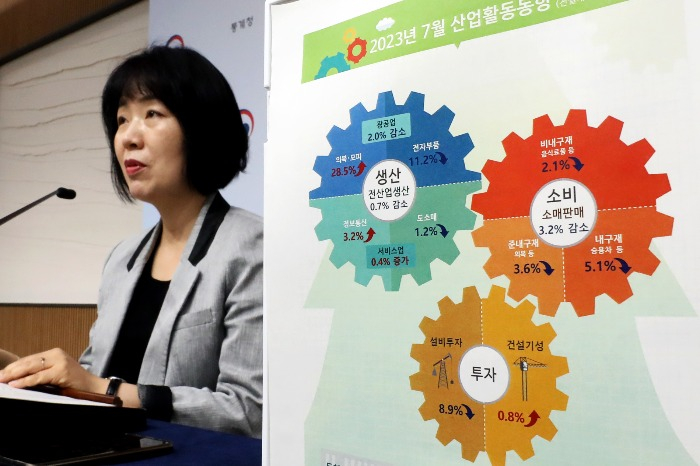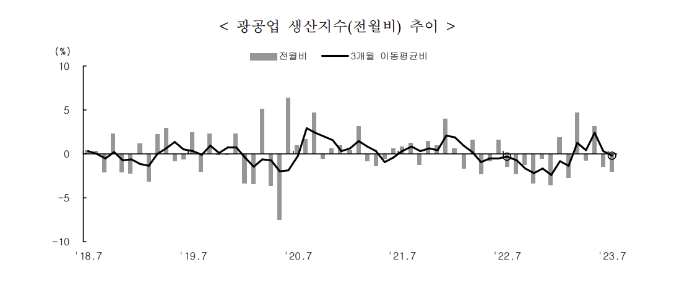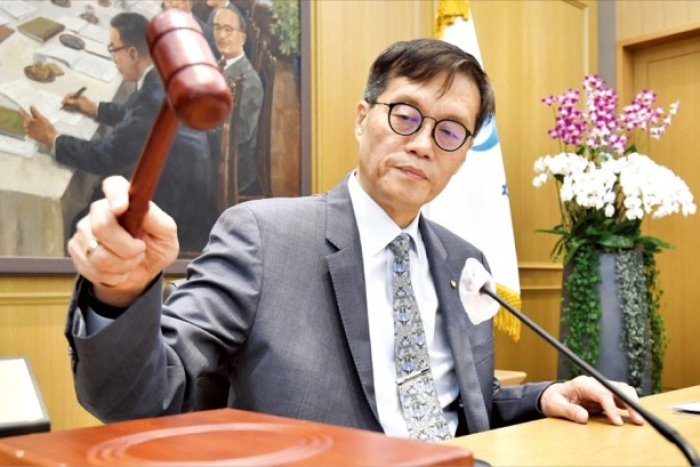Economy
Korea’s July factory output slows at fastest pace since February
Asia’s fourth-largest economy is losing steam with a slowdown in manufacturing, investment and consumption
By Aug 31, 2023 (Gmt+09:00)
3
Min read
Most Read
LG Chem to sell water filter business to Glenwood PE for $692 million


Kyobo Life poised to buy Japan’s SBI Group-owned savings bank


KT&G eyes overseas M&A after rejecting activist fund's offer


StockX in merger talks with Naver’s online reseller Kream


Mirae Asset to be named Korea Post’s core real estate fund operator



South Korea’s factory output contracted at the fastest rate in six months last month on subdued global demand especially from China, while its two other key economic indicators -- retail sales and facility investment -- also slowed, justifying a lengthy timeout in the central bank’s tightening moves.
According to data from Statistics Korea on Thursday, seasonally adjusted mining and manufacturing output in July fell 2.0% from the previous month, the biggest monthly drop since February.
Against the same month of last year, it retreated 8%, the fastest since April.
TRIPLE NEGATIVE
Weak factory activity led the country’s overall industrial activity in the month to slow 0.7% from the previous month after more than offsetting a 0.4% gain in the service sector.
Manufacturing activity waned last month mainly due to the protracted slump in the export-reliant country’s outbound shipments amid the global economic downturn, especially the delayed economic recovery in its biggest trading partner China.
Korea’s exports fell 16.5% to $50.3 billion in July from a year earlier, the largest drop since May 2020, according to the Ministry of Trade, Industry and Energy. It was the 10th straight decline.
The output of electronic components and parts skid 11.2% on-month in July, semiconductors dropped 2.3%, and machinery equipment decreased 7.1%.

Worse yet, retail sales, a barometer of private consumption, fell 3.2% on-month in July on a seasonally adjusted basis, the biggest drop since July 2020, while facility investment shrank 8.9%, accelerating its decline from its 1.1% fall a month earlier. It was the fastest retreat since March 2012.
It was the first time that all three key economic indicators -- industrial activity, retail sales and investment -- have dropped since January this year.
“The economy showed signs of cooling,” said Kim Bo-kyung, a senior official at Statistics Korea who briefed the press about July industrial output data on Thursday. “Retail sales and facility investment fell by a big margin due to the stagnant automobile sales.”
She also noted that the unusually long rainy season in July partly dampened private consumption.
Sales of durable goods declined 5.1% in July, led by the weak automobile demand upon the expiry of the country’s car purchase tax cut scheme. Sales of other semi-durable and non-durable goods also declined.
Factory operation averaged 70.2% in the month, 1.6 percentage points lower than the previous month, while inventory levels rose 1.6% on-month and 5.2% on-year.
RATE FREEZE
As the Korean economy shows signs of cooling, the Bank of Korea is expected to stand pat with its latest stance of keeping the policy rate at the current level of 3.50% for a while.

The Korean central bank left the base interest rate at 3.50% for a fifth straight meeting in a unanimous decision a week ago.
On the same day, the BOK cut its growth forecast for the country’s economy for 2024 to 2.2% from the previous 2.3%. It maintained this year’s growth at 1.4% but warned growth in Asia’s fourth-largest economy could fall to as low as 1.2%.
BOK Governor Rhee Chang-yong, however, said the bank left the door open for another rate hike or hikes this year due to the country’s mounting household debts.
The cyclical component of the composite coincident index, which reflects the current economic situation, retreated 0.5 points on-month to 99.6 in July, while the cyclical component of the composite leading index, which predicts the turning point in the business cycle, added 0.4 points to 99.3, according to Statistics Korea.
The Korean government forecast the country’s industrial output will improve starting September or October after remaining subdued in July and August, said Choi Sang-mok, the senior presidential secretary for Economic Affairs.
Write to Sang-Yong Park at yourpencil@hankyung.com
Sookyung Seo edited this article.
More to Read
-
 Central bankBOK chief’s top mission: Soft landing for household debt
Central bankBOK chief’s top mission: Soft landing for household debtAug 24, 2023 (Gmt+09:00)
2 Min read -
 Central bankBOK head says Korea inflation to dip below mid-2% in H2 2024
Central bankBOK head says Korea inflation to dip below mid-2% in H2 2024Aug 22, 2023 (Gmt+09:00)
1 Min read -
 EconomyKorea exports down the most in 3 years; BOK may keep rates
EconomyKorea exports down the most in 3 years; BOK may keep ratesAug 01, 2023 (Gmt+09:00)
1 Min read -
 Business & PoliticsKorea’s trade deficit with China runs deep; chip support required
Business & PoliticsKorea’s trade deficit with China runs deep; chip support requiredJun 29, 2023 (Gmt+09:00)
3 Min read -
 EconomyKorea’s current account swings to deficit, four-month figures worsen
EconomyKorea’s current account swings to deficit, four-month figures worsenJun 09, 2023 (Gmt+09:00)
2 Min read
Comment 0
LOG IN


